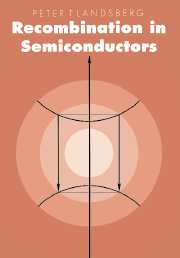Book contents
- Frontmatter
- Contents
- List of main symbols
- Note on units
- Introduction
- 1 Semiconductor statistics
- 2 Recombination statistics
- 3 Auger effects and impact ionization (mainly for bands)
- 4 Radiative recombination (mainly for bands)
- 5 Defects
- 6 Multiphonon recombination
- 7 Recombination in low-dimensional semiconductor structures
- Appendix A The delta function (section 3.2)
- Appendix B Useful identities arising from the periodic boundary condition (section 3.4)
- Appendix C Fourier expansions (section 3.4)
- Appendix D The effective mass sum rule and the dynamics of Bloch electrons (section 3.6)
- Appendix E Diagonalization and Jacobian for the threshold energy and impact ionization calculation (section 3.5.7)
- Appendix F The saddle-point method, and the method of stationary phase (section 6.3)
- Appendix G Evaluation of the integral (6.6.12) (section 6.6)
- References
- Index of names
- Index of topics, concepts and materials
7 - Recombination in low-dimensional semiconductor structures
Published online by Cambridge University Press: 22 September 2009
- Frontmatter
- Contents
- List of main symbols
- Note on units
- Introduction
- 1 Semiconductor statistics
- 2 Recombination statistics
- 3 Auger effects and impact ionization (mainly for bands)
- 4 Radiative recombination (mainly for bands)
- 5 Defects
- 6 Multiphonon recombination
- 7 Recombination in low-dimensional semiconductor structures
- Appendix A The delta function (section 3.2)
- Appendix B Useful identities arising from the periodic boundary condition (section 3.4)
- Appendix C Fourier expansions (section 3.4)
- Appendix D The effective mass sum rule and the dynamics of Bloch electrons (section 3.6)
- Appendix E Diagonalization and Jacobian for the threshold energy and impact ionization calculation (section 3.5.7)
- Appendix F The saddle-point method, and the method of stationary phase (section 6.3)
- Appendix G Evaluation of the integral (6.6.12) (section 6.6)
- References
- Index of names
- Index of topics, concepts and materials
Summary
Introduction
In this chapter, an introduction to the theory of recombination in low-dimensional semiconductor structures is given. A low-dimensional semiconductor structure is one whose dimensions (i.e. layer thicknesses) are smaller than, or comparable to, the de Broglie wavelength of the carriers. An example of such a structure is a quantum well (QW), which consists of a small band-gap semiconductor, of width L, sandwiched between two larger band-gap semiconductors. If L is less than or equal to the de Broglie wavelength of the carriers, then the carriers are confined in the smaller band-gap material, although they are still free to move in the plane of the well. Thus, a two-dimensional electron (and hole) gas can be formed, whose density of states is significantly altered from the bulk (three-dimensional) density of states. The two-dimensional density of states has potential advantages for lasers utilizing such QW structures, as will be explained in the later sections of this chapter. The aim of this chapter is to give a simple description of the physics of QW structures, and to outline the reasons why devices employing such structures have possible advantages over conventional devices. The main emphasis will be on the physics of QWs for laser applications. The problems associated with long wavelength semiconductor lasers are outlined, and the use of QW lasers as a possible solution for the reduction of threshold currents and their temperature sensitivity in such systems is discussed.
- Type
- Chapter
- Information
- Recombination in Semiconductors , pp. 481 - 510Publisher: Cambridge University PressPrint publication year: 1992



